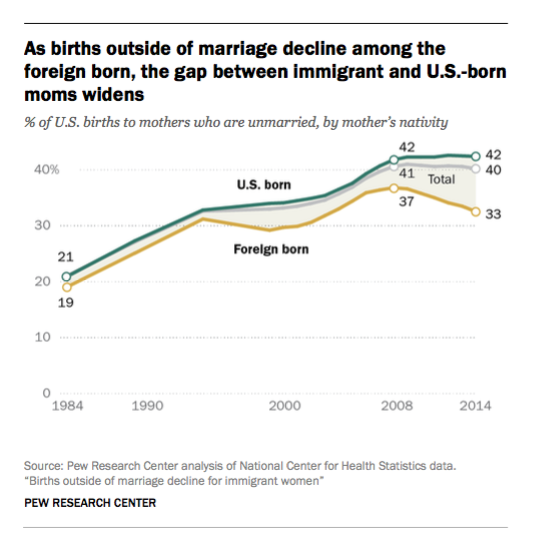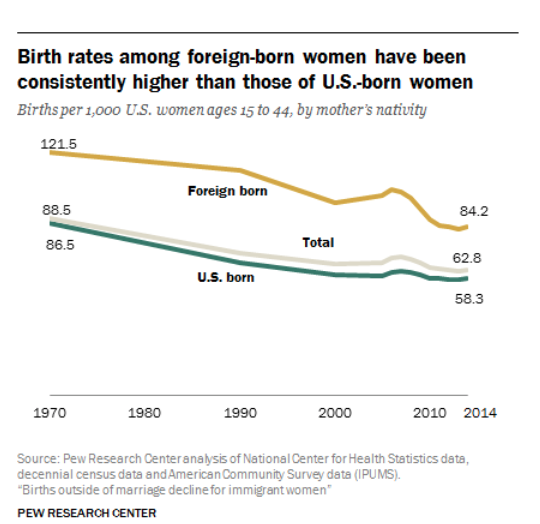Highlights
As we’ve documented on this blog, marriage continues to be central to family formation among the immigrant population in the United States. Despite lower levels of education and income, immigrants are more likely to be married than their U.S.-born counterparts, and immigrant children are more likely to live with two parents than non-immigrant children.
It is perhaps not surprising, then, that immigrant women are less likely than U.S.-born women to give birth outside of marriage. This finding is detailed in a recent Pew Research report, which analyzes National Center for Health Statistics data, and shows that unmarried births have declined significantly among immigrant women.
The report credits the recent stabilization in the share of unmarried births in the U.S. to sharp declines in unmarried births among foreign-born women. After peaking at 37 percent in 2008, 33 percent of all births to immigrant women occurred to unmarried mothers in 2014. By comparison, 42 percent of all births to U.S.-born women occurred outside of marriage in 2014.
Although the share of unmarried births “has consistently been higher for U.S.-born women than for immigrant women,” the report explains, “the roughly 10-point gap between the two groups in 2014 is the largest disparity since birth data by nativity and marital status became available 30 years earlier.”

According to Pew, the decline in unmarried births among immigrant women is partly due to the “changing regions of birth” for new foreign-born mothers:
The share of babies born to moms from Latin America has declined, while the share of babies born to moms from regions such as Asia has increased. New foreign-born mothers from Latin America were roughly four times as likely as moms from Asia to be unmarried in 2014.
But another important factor is the drop in fertility rates among unmarried immigrant women. The birth rate for unmarried immigrants declined a stunning 33 percent between 2008 and 2014—from 90.0 to 60.4.
Even as unmarried births have declined among foreign-born women, overall births among immigrant women have increased, a fact that the Pew credits “entirely” for the long-term increase in the annual number of U.S. births since 1970. In 2014, 23 percent of newborns were born to foreign-born mothers. According to the report:
In 2014, immigrant women accounted for about 901,000 U.S. births, which marked a threefold increase from 1970 when immigrant women accounted for about 274,000 births. Meanwhile, the annual number of births to U.S.-born women dropped by 11% during that same time period, from 3.46 million in 1970 to 3.10 million in 2014.
While the increase in immigrant births is likely due in part to the influx of immigrants to the U.S., another reason is that immigrant women simply have more babies than U.S.-born women. “Birth rates for both groups have declined since 1970,” the report notes, “but the 2014 rate for foreign-born women is about the same as the rate for U.S.-born women four decades earlier.”As the figure below shows, in 2014, there were 58.3 births for every 1,000 U.S.-born women aged 15 to 44, versus 84.2 to foreign-born women.

The decline in unmarried births among foreign-born women is good news for immigrant parents and their children, who account for about one-quarter of the share of U.S. children. It is also further evidence of a healthy marriage culture among the immigrant population that deserves to be supported, and may partly explain why so many young adults with immigrant parents tend to thrive, despite growing up in economically-challenging circumstances.














